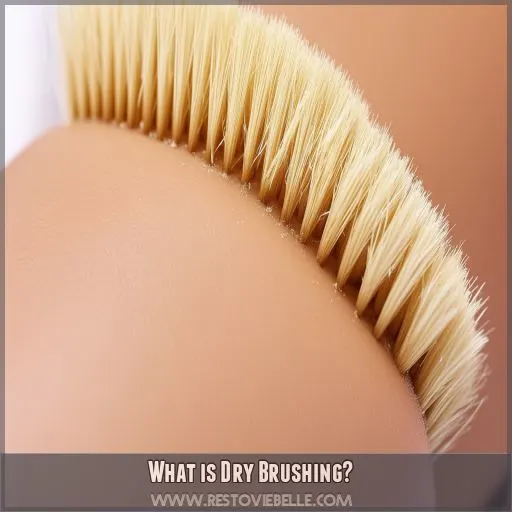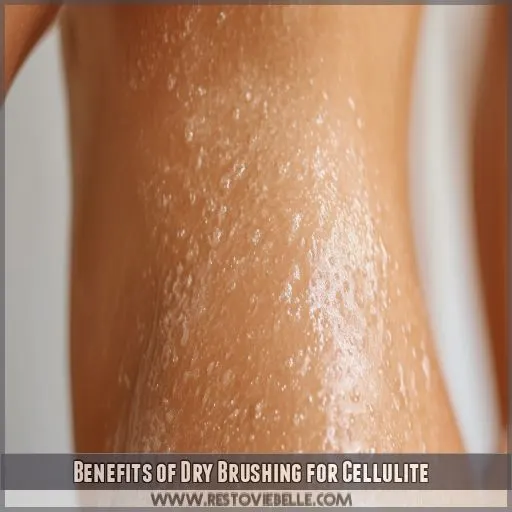This site is supported by our readers. We may earn a commission, at no cost to you, if you purchase through links.
 Are you intrigued by dry brushing for cellulite? You are not alone. An ancient skin care process, dry brushing has been advocated as one of the treatments for these annoying dimples. But is it so?
Are you intrigued by dry brushing for cellulite? You are not alone. An ancient skin care process, dry brushing has been advocated as one of the treatments for these annoying dimples. But is it so?
This article takes us further into the science behind dry brushing for cellulite, its potential benefits, and how to include it in your skincare routine. Learn if this is a secret to smooth skin or another beauty myth.
Get ready to grasp control of your skin’s appearance and discern the truth behind this popular technique.
Table Of Contents
- Key Takeaways
- Understanding Cellulite
- What is Dry Brushing?
- Benefits of Dry Brushing for Cellulite
- How to Dry Brush Correctly
- Combining Dry Brushing With Other Techniques
- Potential Risks and Precautions
- Realistic Expectations and Alternative Treatments
- Frequently Asked Questions (FAQs)
- Does dry brushing actually help cellulite?
- How many times a week should I dry brush for cellulite?
- Does dry brushing tone legs?
- How long does it take to see results from dry brushing?
- How often should I replace my dry brush?
- Can I dry brush while pregnant or breastfeeding?
- Is it better to dry brush morning or night?
- Can I use body oil while dry brushing?
- How long does it take to see results?
- Conclusion
Key Takeaways
- Dry brushing isn’t a magic wand for cellulite, but it’s got some tricks up its sleeve – think smoother skin, better circulation, and a bit of that "I just came from the spa" glow.
- Don’t go brush-crazy! 2-3 times a week is the sweet spot. Like Goldilocks, you want it just right – not too much, not too little.
- Patience is key, folks. Rome wasn’t built in a day, and your cellulite won’t vanish overnight. Give it a few months of consistent brushing before you expect to see results.
- Remember, cellulite is as common as bad hair days – 80-90% of women have it. So while you’re dry brushing away, don’t forget to give your body some love, dimples and all!
Understanding Cellulite
You might think cellulite only affects certain body types, but it’s a common condition that impacts 80-90% of women, regardless of their size or fitness level. The dimpled appearance occurs when fat cells push against connective tissue, creating a tug-of-war effect beneath your skin’s surface.
Causes of Cellulite
You’ve often wondered what causes cellulite. It has nothing to do with fat cells per se. More to the point, it’s a kind of tug-of-war between your connective tissue and those pesky fat cells at work.
To this mix, add hormonal influences and genetic predisposition. Sometimes, lifestyle factors are also to blame for the dimpled skin you’re fighting.
Knowing these causes is thus the first step toward smoother skin and possibly including dry brushing as a wellness technique later on.
Who is Affected by Cellulite
You’re not alone in your cellulite struggle. This common skin concern affects people across diverse demographics, but some groups are more prone than others. Let’s break down who’s likely to experience cellulite:
- Women: 80-90% affected
- Men: Less common, but not immune
- All body types: From slim to curvy
- Age groups: Can appear at any age, often increasing with time
Hormonal influences and personal experiences play significant roles in cellulite formation, impacting skin care routines and anti-cellulite treatment choices.
What is Dry Brushing?
Dry brushing is an ancient practice that’s recently gained popularity for its potential skin benefits, including cellulite reduction. It involves using a natural bristle brush to gently exfoliate your skin in specific patterns, which is believed to stimulate circulation and support lymphatic drainage.
History and Origins
Dry brushing’s roots trace back to ancient civilizations, including Ayurvedic medicine and traditional Chinese practices like gua sha. These cultures recognized the power of skin stimulation for improved blood circulation and lymphatic drainage.
Over time, this technique has gained global popularity, adapting to modern wellness routines.
Today, you’ll find dry brushing celebrated for its potential to remove toxins and promote overall skin health.
How Dry Brushing Works
Dry brushing is a simple yet effective technique for skin health and potential cellulite reduction. You’ll use a brush with natural bristles to make circular motions on your skin, supporting lymphatic drainage and exfoliation. This self-care practice offers more than just smooth skin:
- Boosts circulation
- Removes dead skin cells
- May help break down fatty deposits
Benefits of Dry Brushing for Cellulite
Dry brushing is likely to benefit cellulite reduction because it impacts skin health, circulation, and lymph drainage. Such a technique—exfoliating dead skin cells, then going on to increase the blood flow—might, therefore, make cellulite less dimpled in appearance and take a dusting off the vitality of the skin in general.
Exfoliation and Skin Health
Dry brushing’s exfoliating benefits are like giving your skin a fresh start. As you sweep away dead cells, you’re not just revealing softer skin – you’re kickstarting skin cell regeneration.
The brush bristle materials matter; natural fibers are your skin’s best friend.
While it’s no laser therapy, incorporating dry brushing into your skincare routines can leave you feeling refreshed and your skin looking revitalized.
Circulation and Lymphatic Drainage
Dry brushing isn’t just about exfoliation; it’s a powerful technique for boosting your circulation and stimulating your lymphatic system. As you glide the brush bristles across your skin, you’re:
- Increasing blood flow to the surface
- Encouraging lymph movement
- Helping flush out toxins
- Energizing your body
This circulation boost can leave you feeling invigorated, while potentially improving skin texture and overall health. It’s like giving your body a wake-up call, inside and out!
Potential Cellulite Reduction
While improved circulation and lymphatic drainage are promising, you’re likely wondering if dry brushing can actually reduce cellulite. The truth is, results vary.
Your body shape, skin hydration, and brush type all play a role. Applying the right brush pressure with proper bristle length may help break up fat deposits, but don’t expect miracles.
Consistency is key for potential improvements in skin texture and appearance.
How to Dry Brush Correctly
To dry brush effectively, you’ll need to choose the right tool and master the proper technique. Let’s explore how to select a brush with natural bristles and learn the step-by-step process for dry brushing your skin to potentially reduce cellulite and improve circulation.
Choosing the Right Brush
How to choose an excellent dry brushing tool:
You want to go for one with natural bristles since these will be gentler on your skin and kinder to the environment.
Heavier bristle length is best suited for thicker skin types, while softer bristles are for sensitive areas. Long handles can give you access to awkward places, and shape will impact maneuverability.
But you know this little brush will save you from cellulite, so honestly, you want to take your time with this choice.
Step-by-Step Technique
Now that you’ve picked out your brush let’s talk technique.
Do it on dry skin before you shower. Always use light pressure and long, sweeping strokes, working toward the heart.
Start at the soles of your feet and work up your legs, arms, and lastly, your torso—avoiding sensitive areas and broken skin.
Brush frequency depends on the skin type, but most often, 2–3 times a week is typical.
Combining Dry Brushing With Other Techniques
You can enhance your dry brushing routine by combining it with other cellulite-fighting techniques. Gua sha, a traditional Chinese practice, and massage with essential oils can complement dry brushing to potentially improve circulation and break up fat deposits more effectively.
Gua Sha for Cellulite
Gua sha, an ancient Chinese technique, can complement your dry brushing routine for cellulite reduction. This practice involves scraping the skin with a smooth tool to promote circulation and break up fat deposits. Here’s what you need to know:
- Technique: Use gentle to moderate pressure, stroking upward in long, sweeping motions.
- Benefits: Improves lymphatic drainage, stimulates collagen production, and may reduce cellulite appearance.
- Frequency: Aim for 2-3 times a week, adjusting based on your skin’s response.
Massage and Essential Oils
Take your dry brushing routine to the next level by adding massage and essential oils.
Massage the skin with light pressure; knead the skin in cellulite areas.
Use oils that stimulate blood circulation, like grapefruit or juniper berry. This will increase your results significantly and give you the invigoration of having smoother skin.
Be regular in applying—keep it part of your ritual for optimum benefits.
Potential Risks and Precautions
While dry brushing offers potential benefits, it’s not suitable for everyone. If you have sensitive skin, open wounds, or certain skin conditions like eczema or psoriasis, you’ll need to exercise caution or avoid dry brushing altogether.
Skin Sensitivities and Conditions
While dry brushing can offer benefits, it’s not suitable for everyone. If you have sensitive skin or certain conditions, proceed with caution. Here are four key considerations:
- Thin or delicate skin may be prone to irritation
- Open wounds or infections can worsen with brushing
- Skin conditions like eczema or psoriasis may flare up
- Sunburned or recently shaved skin needs time to heal
Always listen to your body and consult a dermatologist if you’re unsure.
When to Avoid Dry Brushing
While dry brushing can be beneficial, it’s not for everyone.
Skip this technique if you have open wounds, skin inflammation, or sensitive skin conditions like eczema or psoriasis. It’s also wise to avoid dry brushing if you’re sunburned or have recently had cosmetic procedures.
If you’re unsure, consult a dermatologist before starting.
Realistic Expectations and Alternative Treatments
While dry brushing can offer immediate skin benefits, it’s important to set realistic expectations for cellulite reduction, which may take weeks or months of consistent practice. If you’re looking for faster or more dramatic results, you might consider alternative cellulite treatments like radiofrequency, laser therapy, or subcision, which target the underlying causes of cellulite more directly.
Timeline for Results
With dry brushing in the case of cellulite, patience is a virtue. You might feel some more or less immediate benefits, but the long-term effects take their time. Here’s what you can expect:
- The improved skin texture saw use within weeks.
- Reduces the cellulite appearance; this may happen probably in 1-3 months.
- Blood flow and lymphatic drainage may improve within days.
- Gradual firming of skin over several months
Other Cellulite Reduction Methods
While dry brushing can help, it’s not the only way to tackle cellulite. You’ve got options!
Radiofrequency treatments heat tissues, while laser therapy breaks up fibrous bands. Subcision releases tough bands causing dimpling, and electromagnetic shockwave therapy improves skin smoothness.
Don’t forget anti-cellulite creams with caffeine and retinol.
Frequently Asked Questions (FAQs)
Does dry brushing actually help cellulite?
Debunking dry brushing‘s direct effects: While you’ll witness wonderfully exfoliated skin, it won’t work wonders on cellulite. You’re stimulating circulation, which can temporarily plump skin, but it’s not a magic solution for those stubborn dimples.
How many times a week should I dry brush for cellulite?
You should dry brush 2-3 times a week for best results. Start with once weekly and gradually increase. Be gentle on your skin and listen to your body. Consistency is key, but don’t overdo it.
Does dry brushing tone legs?
Just as a sculptor molds clay, dry brushing can sculpt your legs. While it won’t directly tone muscles, it’ll boost circulation, exfoliate skin, and may reduce the appearance of cellulite. You’ll feel invigorated and your legs smoother.
How long does it take to see results from dry brushing?
You’ll likely notice softer, smoother skin within a week of consistent dry brushing. However, any visible changes in cellulite appearance may take 4-6 weeks of daily practice. Remember, individual results can vary based on your skin’s response.
How often should I replace my dry brush?
You’ll want to replace your dry brush every 6-12 months, depending on usage. If bristles become frayed or soft, it’s time for a new one. Regular cleaning and proper storage can extend your brush’s lifespan.
Can I dry brush while pregnant or breastfeeding?
You can dry brush while pregnant or breastfeeding, but consult your doctor first. Use gentle pressure and avoid sensitive areas. It’s best to wait until after delivery if you’re concerned. Always listen to your body’s signals.
Is it better to dry brush morning or night?
You’ll benefit from dry brushing in the morning to kickstart your day. It’ll energize you and boost circulation. However, if relaxation‘s your goal, nighttime brushing can help you unwind before bed. Choose what fits your routine best.
Can I use body oil while dry brushing?
You shouldn’t use body oil while dry brushing. It’ll interfere with the exfoliation process. Instead, brush your skin when it’s dry, then shower and apply oil afterwards. This routine maximizes the benefits of both practices.
How long does it take to see results?
You’ll likely notice softer, smoother skin within a week or two. However, for visible changes in cellulite appearance, you’ll need to be patient. Consistent practice over several months is key to seeing significant results.
Conclusion
Studies show that 80-90% of women experience cellulite at some point.
While dry brushing for cellulite isn’t a miracle cure, it can be a valuable addition to your skincare routine. This technique offers benefits like improved circulation and exfoliation, which may contribute to smoother-looking skin.
Ultimately, embracing your body’s natural beauty is just as important as any treatment you choose to pursue.











